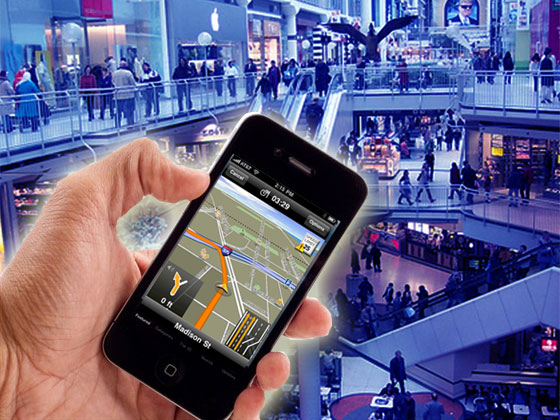Ultra WideBand (UWB) Radio Indoor Positioning System (HERE2)
Overview
Over the last decade, positioning functionality has become ubiquitous through satellite navigation with the Global Positioning System (GPS). Satellite navigation is currently omnipresent in society, supporting a huge variety of services. The most popular service is car navigation, an area in which the Dutch company Tom-Tom is playing a significant role. Further services on the consumer mass-market include personal navigation (e.g. through a GPS-chip in a mobile phone), friend-finding, gaming, and Location-based Services in general. Professional applications include tracking of personnel, for instance search and rescue emergency workers, and tracking of assets like equipment and vehicles, for instance in a complex organisation like a hospital or a large airport, with the goal of improving logistics, safety and efficiency.Professional users of positioning services, and in particular mass-market consumers expect that positioning functionality will be available everywhere, just like telecommunication functionality. In particular where these services are needed most - typically in built-up areas and indoor - satellite navigation performs worst. The many objects in the direct environment cause signal reflections, and a large amount of multipath signals is received by the user, deteriorating the position accuracy, and in many cases too much blockage of the satellite signals denies positioning functionality at all. These environments call for a wideband signal, instead of a narrowband satellite navigation signal (to be able to resolve multipath), and local transmissions (to be able to receive sufficient signal power, possibly after penetrating one or more objects, with sufficient frequency diversity).
Satellite navigation through GPS, and the European Galileo currently under development, needs to be complemented by a local (indoor) positioning system to be able to provide everywhere and seamless positioning functionality. The required fundamental properties above set forward Ultra-Wideband (UWB) as a promising candidate. To say, UWB mitigates the problems of contemporary positioning systems. In the previous STW HERE-project we have successfully shown that through timing of UWB radio signals between nodes (as transmitter and receiver), ranges can be measured at cm-level accuracy
Research
The central research question of the HERE-project was: "Can we accomplish indoor positioning using UWB radio signals?". The answer clearly reads: "Yes, we can!". The project delivered elementary building blocks of an UWB radio indoor positioning system, like a channel model for ranging, signal and receiver design, and positioning algorithm. The aim of the HERE-2 project is to make it really work. The goal is to build a working prototype of a scalable system, thereby targeting low-complexity end-user devices and down to centimetre-level position accuracy.With the knowledge of the HERE-project, still a number fundamental problems needs to be resolved, to make an UWB radio indoor positioning system really work in practice, like multiple access (many nodes are sharing the same frequency spectrum, how to distinguish between them, how to prevent interference), and Line-of-Sight (LoS) versus Non-Line-of-Sight (NLoS) detection and adaptation (reflected and/or delayed signals imply a biased range measurement, and therefore need to be accounted for). Additional requirements - inspired by practical implementation - are that the system shall be easy to deploy and scalable. The solution to be developed shall be inherently optimal with respect to these aspects.
Utilization
Positioning using UWB radio signals is a relatively new area of research and development, with a broad range of applications. Transmitters and receivers are expected to be small devices eventually, that can be integrated in mobile phones, and can be tagged to goods and equipment. Tracking and/or guiding movements of people, vehicles and equipment, also indoor, can enhance the efficiency of work processes and the quality of services.Given the fact that the User-Committee of the past HERE-project doubled during the project, and the large interest shown in this proposed follow-up project, it is anticipated that this new positioning technology and the forthcoming results offer real potential for Dutch industry and business. Building on research assets gained with the past HERE-project, a strong utilisation link is secured by developing an operational prototype system within the proposed project - a significant amount of effort, of nearly two man-years, is dedicated to this. Thereby, chances are high to really take it to the market within a few years from conclusion of this project.
The user committee proposed for this project is well balanced and ranges from institutes, industry, and companies involved in manufacturing hardware, developing applications, to large institutional end-users. Parties that have expressed explicit interest, of which several will actually contribute to the project, are: Septentrio Satellite Navigation (SSN), Re-liON, Amsterdam Airport Schiphol, TNO-FEL, Xsens, TI-WMC, Thales, Rijkswaterstaat, the Ministry of Defense, ESA/Estec.

Project data
| Researchers: | Gerard Janssen, Yan Xie |
|---|---|
| Starting date: | December 2012 |
| Closing date: | December 2016 |
| Funding: | 500 kE; related to group 250 kE |
| Sponsor: | STW |
| Users: | Septentrio Satellite Navigation (SSN), Re-liON, Amsterdam Airport Schiphol, TNO-FEL, Xsens, TI-WMC, Thales, Rijkswaterstaat, the Ministry of Defense, ESA/Estec |
| Contact: | Gerard Janssen |